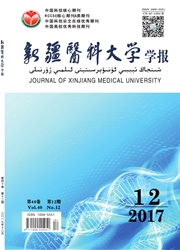

 中文摘要:
中文摘要:
目的通过对变应性鼻炎SARIMA模型的建立,探讨乌鲁木齐市住院患者变应性鼻炎的发病趋势,为该病的预警及防控提供理论依据。方法应用SPSS20.0软件包对乌鲁木齐市2002年1月-2016年5月变应性鼻炎发病率进行初步平稳化处理并建立SARIMA模型。结果 2002年1月-2016年5月变应性鼻炎在乌鲁木齐某三甲医院住院患者处于不断上升趋势,且存在明显的季节周期性变化,每年平均高发月份为7~9月份,利用该模型对乌鲁木齐市2016及2017年各月发病率进行预测,2016年6月-2018年5月乌鲁木齐某三甲医院变应性鼻炎发病人数依然为7、8、9月3个月居多。结论 SARIMA(1,0,0)(1,1,0)12模型能够有效地预测变应性鼻炎的发病趋势,为变应性鼻炎诊治提供积极的指导作用及依据。
 英文摘要:
英文摘要:
Objective To explore the incidence trend of hospitalized patients with allergic rhinitis in Urumqi through the allergic rhinitis SARIMA model,to explore incidence trend of hospitalized patients with allergic rhinitis in urumqi,thereby provide providing theoretical basis for the early warning and prevention and control of the disease.Methods Smooth incidence of allergic rhinitis in preliminary treatment was processed and the SARIMA model was established using SPSS20.0 packages between January 2002 and May 2002 in Urumqi.Results There was increasing trend of patients with allergic rhinitis in one tertiary hospital,marked by periodical changes.The peak incidence month every year was from July to September.Based on the model we′ve established,the prediction was performed regarding the monthly incidence from 2016 to 2017.It showed that one tertiary hospital in Urumqi whose number of patients with allergic rhinitis was expectedly highest in July,August and September from June 2016 to May 2017.ConclusionSARIMA(1,0,0)(1,1,0)model we′ve established in the study was shown to be able to effectively predict the trend of allergic rhinitis incidence,thereby providing positive guidance and basis for the diagnosis and treatment of patients with allergic rhinitis.
 同期刊论文项目
同期刊论文项目
 同项目期刊论文
同项目期刊论文
 期刊信息
期刊信息
